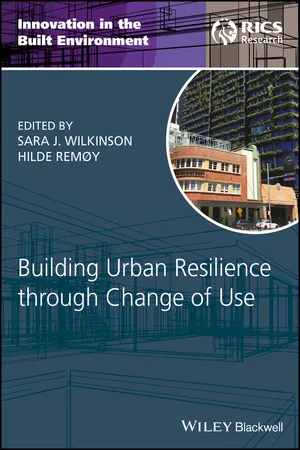
Building Urban Resilience through Change of Use
- English
- ePUB (mobile friendly)
- Available on iOS & Android
Building Urban Resilience through Change of Use
About This Book
Describes all aspects of sustainable conversion adaptation of existing buildings and provides solutions for making urban settlements resilient to climate change
This comprehensive book explores the potential to change the character of cities with residential conversion of office space in order to withstand the negative effects of climate change. It investigates the nature and extent of sustainable conversion in a number of global cities, as well as the political, economic, social, technological, environmental, and legal drivers and barriers to successful conversion. The book also identifies the key lessons learned through international comparisons with cases in the UK, US, Australia, and the Netherlands.
Building Urban Resilience Through Change of Use covers the benefits and aspects of sustainable conversion adaptation through the whole lifecycle from inception, planning, and design, to procurement, construction, and management and operational issues. It illustrates and quantifies, through empirical research, the changes that have been achieved or delivered in sustainable conversion adaptation. The book gives an overview of all aspects of performance characteristics and the conversion adaptation of existing buildings. In the end, it enables planners to make more informed decisions about whether conversion adaptation is a good choice—and if so, which types of sustainability measures are best suited for projects.
- Provides detailed, empirical knowledge based on real-world research undertaken in five countries over three continents on both a citywide scale and on individual buildings
- Case studies and exemplars demonstrate the application of the knowledge in North and South America, Canada, Australia, New Zealand, and in Europe
- Addresses the key themes of technology, finance and procurement, and the regulatory framework
The first research-based book to examine how to improve resilience to climate change through sustainable reuse of buildings, Building Urban Resilience Through Change of Use is a welcome book for researchers and academics involved in building surveying, urban development, and sustainability planning.
Frequently asked questions
Information
1
The Context for Building Resilience through Sustainable Change of Use Adaptation
1.1 Introduction
The 17 Sustainable Development Goals and 169 targets demonstrate the scale and ambition of this new universal Agenda. They seek to build on the Millennium Development Goals and complete what they did not achieve. The Sustainable Development Goals are integrated and indivisible and balance the three dimensions of sustainable development: the economic, social and environmental. The Goals and targets will stimulate action over the next 15 years in areas of critical importance for humanity and the planet.(UN, 2015: 1)
- Goal 6. ‘Ensure availability and sustainable management of water and sanitation for all’,
- Goal 7. ‘Ensure access to affordable, reliable, sustainable and modern energy for all’
- Goal 11. ‘Make cities and human settlements inclusive, safe, resilient and sustainable’ (UN, 2015).
Box 1.1 UN sustainable development goals.
| Goal 1 | Zero poverty: End poverty in all its forms everywhere. |
| Goal 2 | Zero hunger: End hunger, achieve food security and improved nutrition and promote sustainable agriculture. |
| Goal 3 | Good health and wellbeing: Ensure healthy lives and promote well‐being for all at all ages. |
| Goal 4 | Quality education: Ensure inclusive and equitable quality education and promote lifelong learning opportunities for all. |
| Goal 5 | Gender equality: Achieve gender equality and empower all women and girls |
| Goal 6 | Clean water and sanitation: Ensure availability and sustainable management of water and sanitation for all. |
| Goal 7 | Affordable clean energy: Ensure access to affordable, reliable, sustainable and modern energy for all. |
| Goal 8 | Decent work and economic growth: Promote sustained, inclusive and sustainable economic growth, full and productive employment and decent work for all. |
| Goal 9 | Industry, innovation and infrastructure: Build resilient infrastructure, promote inclusive and Sustainable industrialisation and foster innovation. |
| Goal 10 | Reduced inequalities: Reduce income inequality within and among countries. |
| Goal 11 | Sustainable cities and communities: Make cities and human settlements inclusive, safe, resilient and sustainable. |
| Goal 12 | Responsible consumption and production: Ensure sustainable consumption and production patterns. |
| Goal 13 | Climate action: Take urgent action to combat climate and its impacts by regulating emissions and promoting developments in renewable energy. |
| Goal 14 | Life below water: Conserve and sustainably use the world’s oceans, seas and marine resources. |
| Goal 15 | Life on land: Protect, restore and promote sustainable use of terrestrial ecosystems, sustainably manage forests, combat desertification, and halt and reverse land degradation and halt biodiversity loss. |
| Goal 16 | Peace just and strong institutions: Promote peaceful and inclusive societies for sustainable development, provide access to justice for all and build effective, accountable and inclusive institutions at all levels. |
| Goal 17 | Partnership for the goals: Strengthen the means of implementation and revitalize the global partnership for sustainable development. |
1.2 Scale of the Problem: From City to Building Scale
Table of contents
- Cover
- Title Page
- Table of Contents
- About the Editors
- Contributor Biographies
- Acknowledgements
- Foreword: Resilience as a ‘Lens’ for Driving the Adaptive Capacity of Cities
- 1 The Context for Building Resilience through Sustainable Change of Use Adaptation
- 2 Precinct‐scale Innovation and the Sharing Paradigm
- 3 Planning Policy Instruments for Resilient Urban Redevelopment: The Case of Office Conversions in Rotterdam, the Netherlands
- 4 Adaptation and Demolition in a Masterplan Context
- 5 Sustainable Design and Building Conversion
- 6 Top‐up: Urban Resilience through Additions to the Tops of City Buildings
- 7 Conversion Potential Assessment Tool
- 8 Rating Tools, Resilience and Sustainable Change of Use Adaptations
- 9 Conclusions on Building Resilience through Change of Use Adaptation: A Manifesto for the Future
- Index
- End User License Agreement